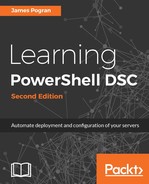We covered how to install DSC pull servers briefly in Chapter 2, DSC Architecture, by showing an example DSC configuration script and listing several steps to configure the server afterward. If we covered it there, why do we need to devote a chapter to it here? Well, for one, we skipped a lot of detail about how to actually use that DSC configuration. We dived right into an example DSC configuration script, but you couldn't actually use it then because we hadn't yet gotten to Chapter 5, Pushing DSC Configurations, where you learned how to push DSC configurations. Installing the first DSC pull server with DSC is like the chicken and egg problem; you want to use DSC pull servers to deploy DSC configurations and handle all the deployment processes for you, but you need to first push a DSC configuration to install the DSC pull server. It will require some one-time setup work, but the initial effort will pay dividends as time goes on and you continue to use the DSC pull server.
If there are extra steps or other problems with installing DSC servers automatically using DSC, why bother? You could, in theory, install a DSC pull server yourself by hand if you wanted to, but it is clearly not an option Microsoft or anyone who uses DSC expects you to take. There are no instructions out there to tell you the steps to do that by hand, and the configuration of the components used by the DSC pull server is not documented for you to reproduce. It would take a lot of time and effort for you to accomplish this, with no substantial benefit to you. There are many complex parts to a DSC pull server that aren't Microsoft DSC-software-specific, so there isn't an MSI or package to distribute to you. As we covered earlier, some components are already present on the target server (IIS, DSC feature, and so on) and others need copying and configuration (IIS website files and OData endpoint configurations). It is a complex set of software that acts together to present one whole or system.
Another reason for devoting a whole chapter to DSC pull servers is that we did not cover the new features of a WMF 5 pull server and how they affect your deployment choices. In WMF 5, the PowerShell team added new target node registration methods as well as a new feature for DSC configurations, called partial configurations. We'll address these new features and changes throughout the course of this chapter.
